This is part 2 of 2. Click here to go back to Part 1.
The search for a new ISP
What can I say, I am legit tired of CANTV’s eternal bs, the instability, latency, having to spoof my MAC address every now and then to bypass throttling and saturated gateways, etc. These worsening problems have gotten so bad that I’ve been leeching off the free wifi off my nearest supermarket as of late to update my phone and upload stuff (in my defense, I’ve blown billions of Bolivars on them on this year alone, so it’s the least they can do).
That free wifi, with speeds much better than what I have at home, is only meant for people to use it for digital payment processors such as Zelle or our local Bank’s apps that are more widespread than ever before in this hyperinflated and pseudo-dollarized nu-Venezuela. As such, they’ve begun to crack down and block a bunch of stuff, but nothing that a VPN can’t fix.
I actually have had days where I take my sweet time picking stuff off the aisles, just walking and strolling while my phone discreetly updates apps and uploads some of my backups to The Cloud™.
Anyways, and regardless of my ongoing quest to migrate out of this country with my brother, I went on a search for a private ISP alternative that operates in this area so that we could at least have some decent internet in the meantime. I kept looking for something that I could first and foremost afford and is a decent bang for my buck (or foreign cash in this case).
And that’s where it all gets complicated.
I started my search with the tried and true staple private ISPs around here: Inter and Netuno. Depending on who you ask, these two either work just fine or are an absolute nightmare. The quality of their service is hit or miss despite their prices, but hey, at least asking if they have anything to offer for me wasn’t gonna hurt anyone.
Both of these companies offer HFC broadband and very decently priced Fiber internet (in very, very limited areas right now), unfortunately, neither of these is available in this area — a shame, because these would’ve been a decent (but by no means optimal) solution that I could more or less afford.
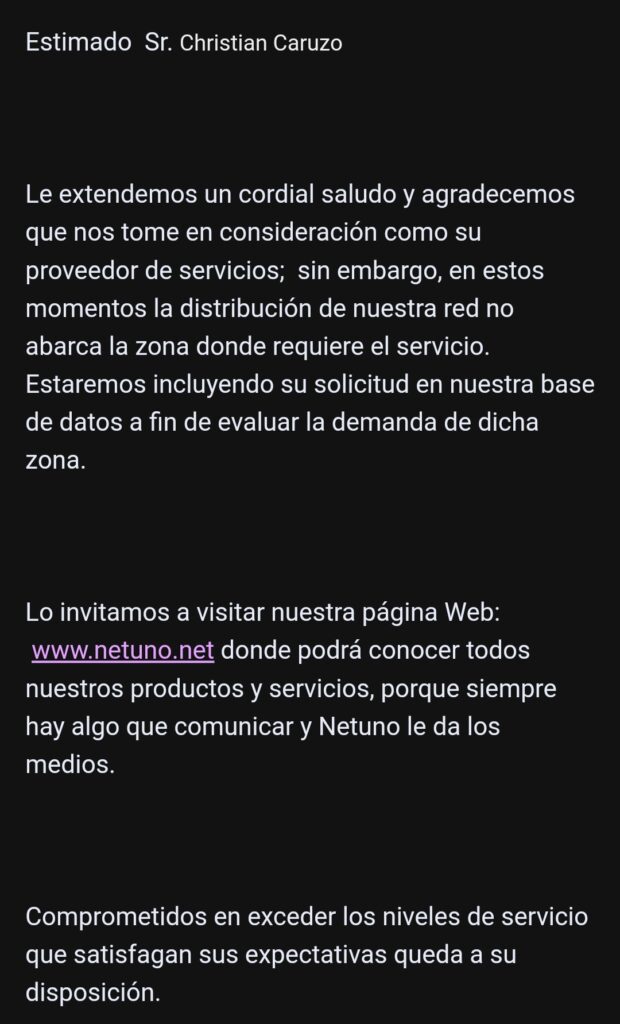
As of 2021, Fiber internet in Caracas is mostly available in the ‘upper class’ parts of the city, and remains a pipedream for the rest of the capital as a whole. Investment and all that corporate stuff aside, this is a very convoluted city to deploy fiber in, as most of the fiber that was initially deployed years ago was reserved for government use and there’s herfy permissions and paperwork to go through — I sure as hell ain’t gonna sit here and wait years for it, I have months to solve my migrant plans (and my life), and I’m not getting any younger either.
The solution to the lack of availability of ‘regular’ private internet service in my area would perhaps rest in the booming Wireless Internet Service Providers, or WISPs.
Or so I thought.
Enter the WISPs
If you’re not fortunate enough to count with a stable ADSL connection via CANTV (which has become rarer and rarer with each passing day), can’t get one of the ‘staple’ private ISP ones, and you’re not blessed with living in one of the few areas that does happen to have fiber internet in Caracas then your only bet at a good internet in this, the seat of power of the Bolivarian Revolution, is to go through these WISPs — and by good I mean higher than 5Mbps download and with uploads that are not in the decimals.
The world of Venezuelan WISPs is a wild west, where everyone does whatever the hell they want — an exemplar carryover from this new normal that we live in. Many of them don’t care how you pay them, they will take anything as long as you pay them: cash, PayPal, foreign wire transfers, ACH transfers between U.S. banks, Crypto, Zelle, and what have you.
What’s the catch then? It’s a simple one: WISPs are expensive, extremely expensive for what they offer in most cases, and their initial setup fees are a monetary barrier that, at least in my case, cannot afford at the moment, especially not when I have to save as much money as possible for my inexorable escape from here.
Realistically speaking, the high price:low bandwidth ratio can be justified by the fact that this is a wireless service that’s inherently expensive by nature, yet, some of these providers act all smug and mighty, and instead of offering a more down to earth explanation as to why they’re so expensive they will instead throw walls of text at you if you dare so much as to say anything negative about their exorbitant prices.
Even getting the basic information about pricing and plans out of them is often hidden behind layers on top of layers of social media secrecy, as if you were conducting a black market deal like the ones from our worst years of shortages.
In most cases, it is not as simple as opening a website and reading through their setup fees and plan charts — no, you have to reach out to them first via Instagram or Twitter, send them a direct message, and then either get the info through DMs, or be forwarded to their WhatsApp number, where you will finally get the info you as a potential customer are requesting.
This practice isn’t something inherent to them, but rather, a bad habit carried over by years and years of regulations, shortages, and what have you — in the case of Instagram, it’s sometimes justified by the way the engagement algorithm works, so people are forced to reply on comments to unwillingly boost the provider’s account metrics — It’s a bad habit that we can’t quite seem to get rid of (as an anecdote, even video game stores have been like this since before the days of social media. Back in my youth they’d refuse to tell you prices for consoles and games out of fear that you were a competitor trying to undercut them).
I scouted several of these WISPs, and out of all of them only a handful provide coverage to this area. Some of these were directly contacted via their WhatsApp number, and they gave me all the info requested there. Others were contacted via Twitter/Instagram, and I was either given the info in a similar manner, or instead sent a link to a Google Docs or PDF file with the info, with a friendly “feel free to ask any questions you may have after reading the file.”
Now, when I said that they’re highly expensive, I meant it, at least for me, not like I’m rich lol.
The initial setup fees for a WISPs in Caracas range anywhere between $250.00 to even upwards of $850.00. Some of them demanded this initial fee to be paid in cash USD, while others were more lenient and accepted many forms of payment as long as you don’t pay in Bolivars.
Out of all that have coverage to this area, only one offered a “flexible” setup fee payment plan, paying half of their $320 setup fee first + the first month of service, and then the remainder alongside the second month of payment. Every other provider wanted their respective setup fees upfront.
As for plans, here’s the chart I was given for both their dedicated and shared plans:
Another provider threw a $450-$580 setup fee at me, with plans starting from 4Mbps, the same 4Mbps that this constantly failing ADSL has given me since 2013.
As for their plans. I was given two very low quality and compressed JPEG files with two types of plans. The first one shows two ‘solidarity’ plans: One with speeds up to 3Mbps for $22.11 per month, and another with speeds up to 5Mbps for $36.87. There is a barely legible fine print that says they only guarantee 15% of upload and 50% of download.
Their other plans range between 6 and 20 Mbps, and are far pricier of course. Despite being that expensive they say they can only guarantee 15% upload and 70% download.
I may be dumb and uneducated, so I don’t know much about networking and whatnot, but if I’m to pay that much then, I don’t know, I’d expect a better service.
My search continued until I stumbled upon the most expensive of the bunch. This provider also has a “Social” plan, which is not available in my area, but it is worth mentioning all the same. $266.80 setup fee, which can be reduced to $203 if you sign up as a group of 6 subscribers — that’s $203 per person btw.
The plan itself goes for $23.20 per month, with speeds that start with 1Mbps and can go all the way to blazing fast 3Mbps.
Even if this plan was available in my area, it’s even slower than what I have.
Now, if that seems too expensive for you, then wait until you see their regular plans.
Their ‘home office’ plan has a whopping $870 setup fee if you go solo, but can be reduced to $203 per person if you sign up as a group of 6 or more. Mind you, I contacted this provider last year, and the solo setup fee was $750 in 2020 as per the PDF file they sent me, so it’s even more expensive in 2021.
Their plan gives you an average 5Mbps speed that can go all the way to 20Mbps, all that for $696 per year or $69.60 per month.
I don’t know about you all, but I’m not one of those guys in cahoots with the regime that are laundering money like madmen through storefronts filled with stuff imported from the United States, there’s no way I can even begin to afford that one.
It is worth mentioning that when I was looking for information about this ISP I went and did my due diligence through a namesearch on Twitter. The first thing I stumbled upon was some dude complaining at them about the constant outages. The response given to that person by the ISP’s account was filled with convoluted explanations that shifted the blame towards the customer and not to them.
So yeah, all that money and no guarantee of stability? I might as well stick to this government ISP, at least with them the instability is guaranteed.
Out of all that I kept contacting, only one seemed somewhat more accessible. An acquaintance hooked me up with the number of sales rep for this other ISP, long story short: $130 setup fee and $30 per month for 10Mbps. Now that’s something I can stretch myself and somewhat afford, even if the setup fee would still incur a financial blow to me.
It was too good to be true, though. That plan is only for multi-apartment signs up, I’d have to convince 9 of my neighbors to sign up with me so that we could each get that plan — good luck with that.
This building has 30 apartments, and over a third of them are empty because they’ve fled the country already, and that setup fee and monthly cost, cheaper than the rest, is still quite the hit for most budgets, don’t forget that this is a country with a steep economic crisis, so there’s that.
They do have a solo plan, which is more in league to the average costs of a WISP, $250 setup fee and $100 per month for 10Mbps down / 7 Mbps up. Or $130 per month for 15 down / 10 up.
Another provider, with a similar name had pretty much the same costs even with an extra $10 monthly fee for ‘renting’ the antenna.
All of these Twitter and Instagram DMs, the back and forth WhatsApp chats, and phone callbacks ended up with the same result.
The only viable solution for decent internet in this area is, plain and simple, too expensive for me. I either eat and provide food for my brother, or have decent internet, can’t have both.
The answer to this is a no-brainer to me, as I would never compromise my brother’s food and wellbeing for a better internet connection, not to mention that having to pay that much per month means that I’d stop being able to save a little each month for our inexorable escape from this country.
Mobile as a last resort
With no HFC or Fiber available in this area, and WISPs being way out of reach for me, I scouted for an alternative into the other greater evil: Mobile internet.
As of early September of 2021, the price per GB is approximately 3,373,465 Bolivars (roughly $0.8) for both Movistar (the carrier that I use) and Digitel. No one cares about the government-owned Movilnet.
It’s hardly cost effective in the long run, but it’s there as a last resort, like when I went one month without ADSL service last year, or when I need to upload something quick, for which I need to wait until past midnight cause that’s when the network is less congested and I get decent speeds out of it.
Still, cost ineffective as it is, there are now hard caps to monthly data that makes it hardly a solution for heavy everyday use.
My carrier removed all prepaid plans for new customers, and I’m stuck with an admittedly cheap grandfathered plan that only gets me 400Mb per month. I can prepay packs of 1-4GB, with a hard cap of 5GB per month, if you go past the 5GB hard cap then you’re out of data until the next month.
Even if I had money to indiscriminately burn in mobile data, it’s only 5GB per month, not to mention that 4G signal barely works around my house, and it only really works decently during late night hours.
For better or for worse, I’ve kept paying for my mom’s old postpaid phone, which has a grandfathered 3G plan with a whopping 100MB per month. This is my ‘in case of emergency’ hotspot device, the one that carried me last year during that ADSL outage.
In spite of all that, Movistar has been aggressively trying to sell me their new “4G Agile Mobile Solution” service, which consists of a $70 4G modem “with better reception that a regular phone,” with average speeds of 5-6Mbps during most of the day for upwards of $70 per month — which has to be paid in Bolivars because of government regulations.
Being mobile data, it is also subject to a monthly data cap of 100GB per month, which you can extend via expensive 50GB packs all the way to 250GB per month max.
Less expensive than the WISPs for sure, but these limitations and bad 4G signal around here do not entice me towards making the investment for an average extra Mbps or two, as there is no guarantee that it’d work.
Movistar has also tipped its toes in the WISP market, offering their own service that has a hefty installation fee that hovers around $500 depending on the materials that they’ll end up requiring. This fee has to be paid to a third party contractor, and, according to the salesperson that called me, its cash only.
The plans range between 5-15Mbps, and the prices are more or less the same as the rest. Because they have to conduct all of their businesses via Bolivars, this service has to be paid in the same manner.
It is borderline hilarious, if not depressing, that their own website tells you that because some banks have a 50,000,000.00 cap per wire transfer, you need to keep doing transfers of 50 million each until you reach your monthly fee.
My cellphone carrier's expensive new internet service is not just a ripoff, it's convoluted to pay for.
— Kaleb (@KalebPrime) August 30, 2021
Because it's that expensive they suggest you do wire transfers of 50 million Bolivars each till you cover the amount of your rent cause 50m is the hard cap for prepaid reloads pic.twitter.com/lcXiGIrMng
50 million Bolivars is roughly $12 right now.
Digitel, the other mobile carrier around these lands, also has some limitations with regards to monthly data caps for regular customers — nothing that a little Venezuelan ‘viveza criolla’ can’t fix.
I was offered an alternative through a provider that sells mobile 4G modems alongside a Digitel SIM card that they will flag onto Digitel’s systems as a corporate account, therefore granting you access to an unlimited corporate plan, paying each month for whatever GB you end up using.
This is provided as-is, and after they hook you up and give you the hardware you’re on your own.
Be that as it may, mobile data is far too inefficient, both cost and stability, to be a main source of internet for my everyday use (and that of my brother). It’s there for emergency situations, or when my ADSL goes down, but nothing more.
Beyond Caracas
Venezuelan life outside of Caracas has always been different in many regards, this is a chaotic and convoluted Frankenstein-esque city made of 5 municipalities stitched together, and yet, things like public utilities are less prone to fail than in other cities.
The rest of the country’s cities are for sure calmer and more ‘peaceful’ than Caracas, but they’ve suffered the worst out of our ongoing collapse, so life would at least give them the upper hand in something, and that upper hand has come in the form of a drastically better internet situation.
While CANTV is just as bad (if not worse) outside of Caracas, the new boom of private ISPs has been hailed as the ‘rebirth’ of Venezuelan internet by some easily impressionable journalists.
The speeds and prices you can find outside of the capital are much better for the customer, 50-100Mbps fiber or WISPs cost a fraction of what private ISPs charge for in Caracas. Zulia, my beloved birthplace, even has 300-600Mbps fiber for only $35 per month, compare that to some of the prices from Caracas’ ISPs that I’ve posted above and well…
The good internet you can find over there hardly masks the misery that many are still going through, such as the ongoing hunger and malnourishment of the majority, the constant blackouts, and an even worse running water situation that makes mine pale in comparison — such are the livelihood discrepancies that have characterized this chapter of Venezuelan history.
Lastly, cheaper as these may be, these are services that not many can afford. Additionally, there’s been many cases of ISPs operating without the government’s proper accreditation, and as such, they can be forcefully shutdown at any given moment, leaving people out of service and of course, with no refunds.
Some speculate that some tomfoolery or even money laundering is involved with these utopic-like ISPs, some say otherwise — I honestly don’t care either way. If you have the resources to raise bubbles around you and brute force all of this country’s woes and shortcomings, then by all means, go for it, do whatever you can to make your life in these lands as less miserable as possible, and that includes internet access.
—
Just like 24/7 access to running water, good and stable internet remains a pipeline dream to me — something I cannot have at the moment, but something that perhaps I’ll get access to if I keep fighting towards building a new life for myself and for my brother.
A friend once told me that he had to move somewhere else in the city just so he could have a stable internet connection to work, and truth be told, I’ve entertained the idea — if only as a hypothetical scenario — but realistically that is something I cannot do or afford in the first place.
Private ISPs are financially out of reach for me right now, and there’s no realistic way to get the ADSL cabling around here fixed. All I can do is hope and pray that this constantly failing ADSL keeps holding on until the day where I can finally board a plane outta here.
So one day, perhaps. Maybe once that day comes I’ll even stream my boomer vidya antics and be able to upload memes and content much faster than what I can with my current average upload speeds of 0.11Mbps.
Until the next one,
-Kal
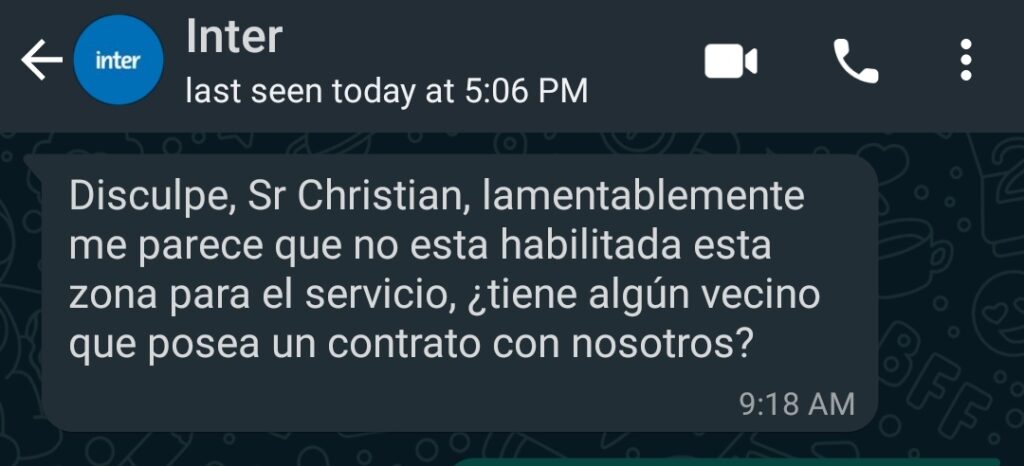
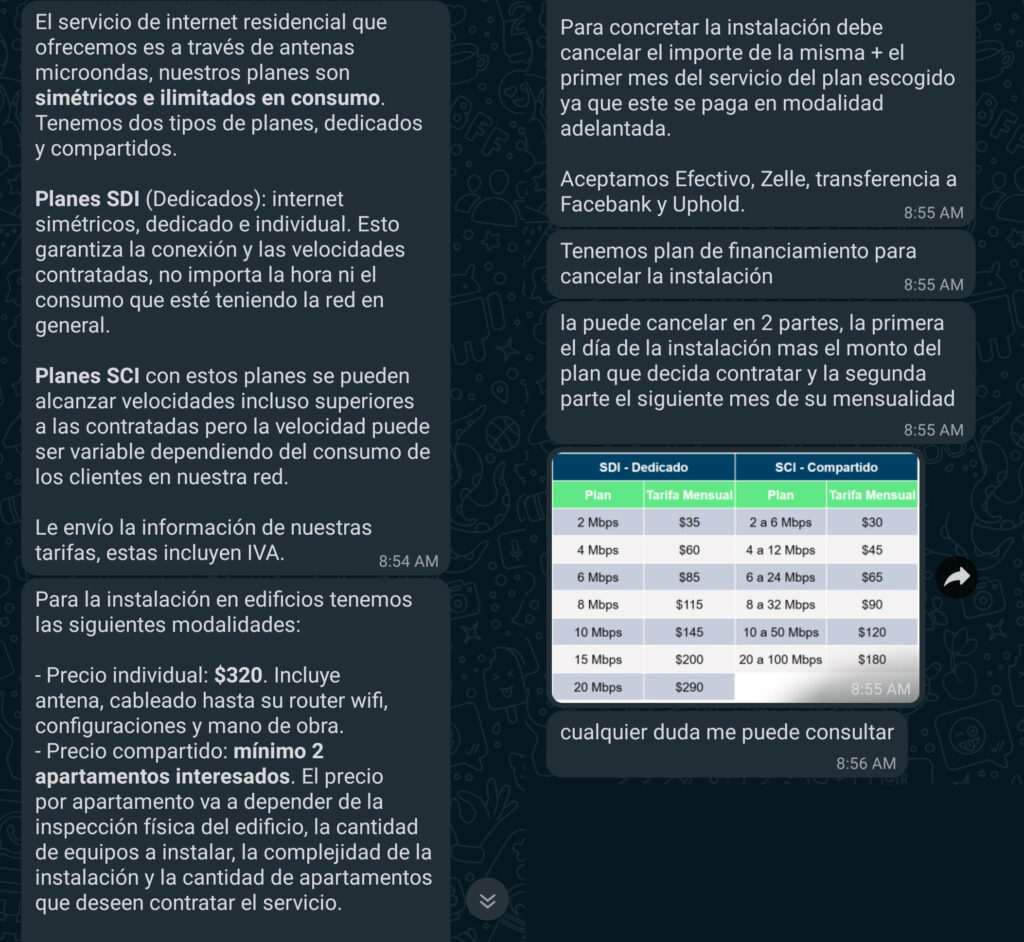
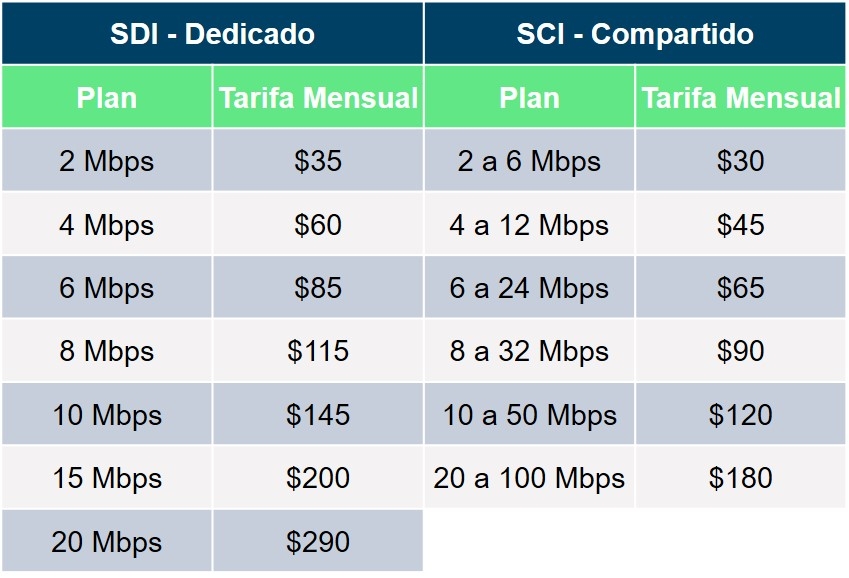
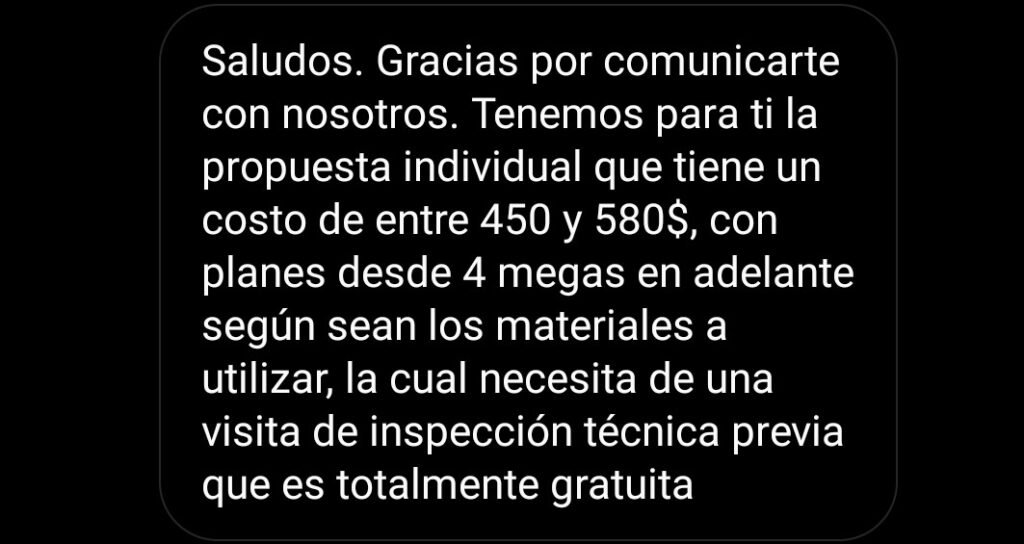
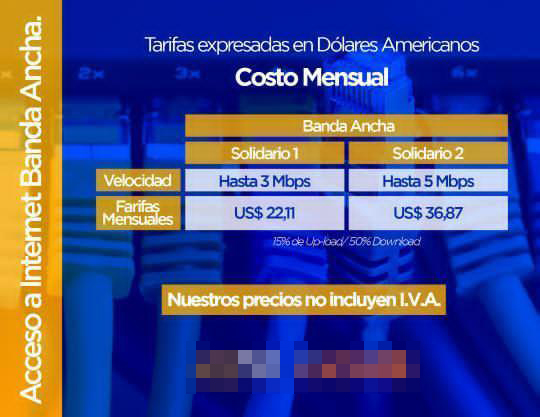
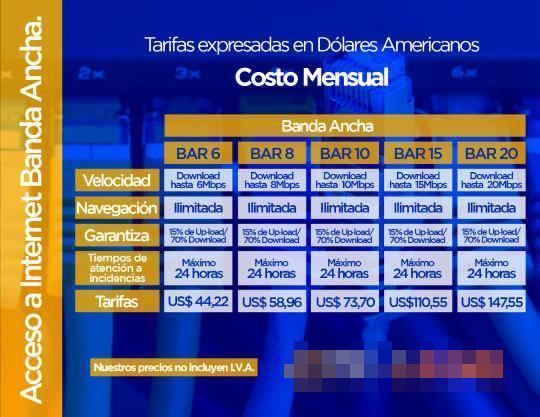
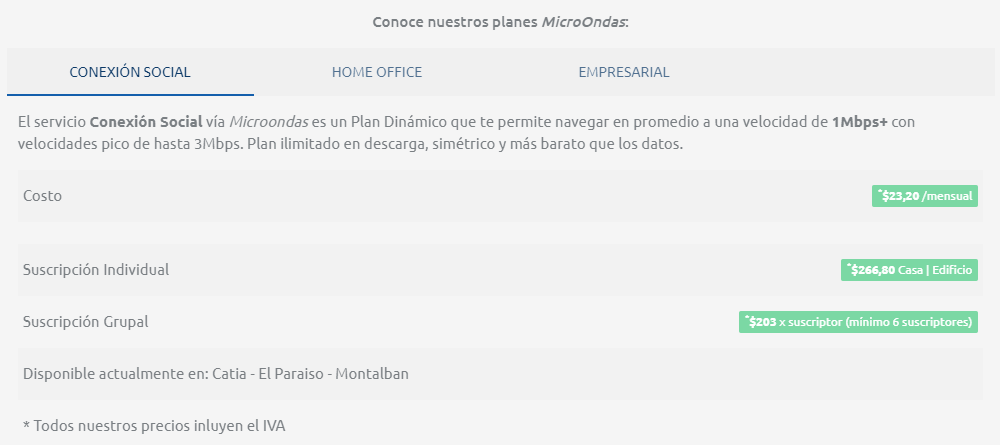
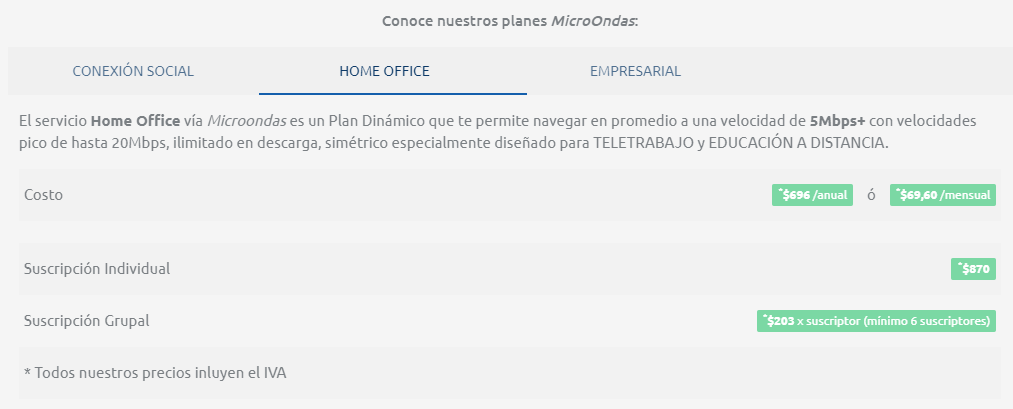
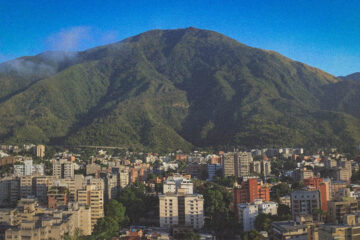


1 Comment
The (absolute) state of Venezuelan internet: 2021 edition. Part I | ckaleb[dot]com · September 11, 2021 at 8:36 pm
[…] This post continues in Part 2, which you can access by clicking here. […]
Comments are closed.